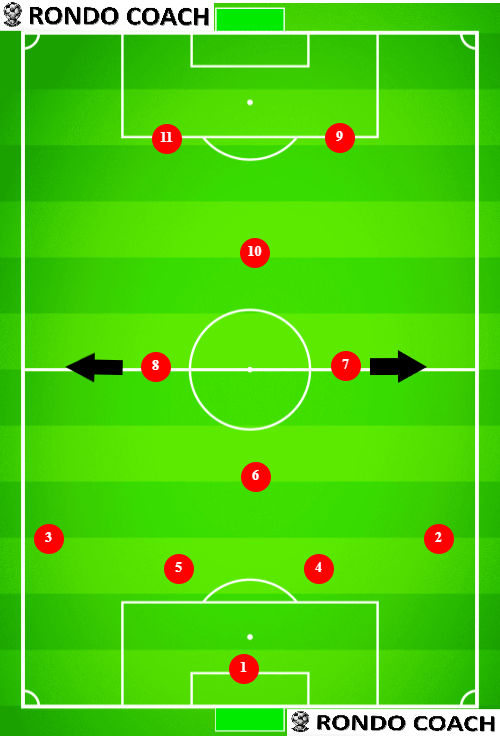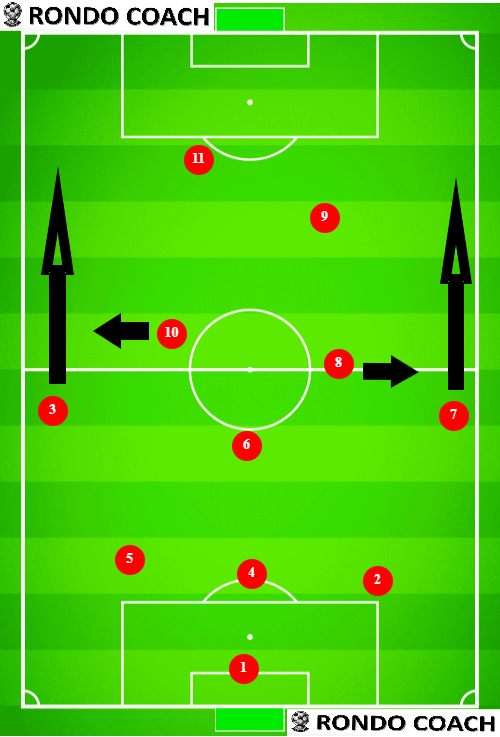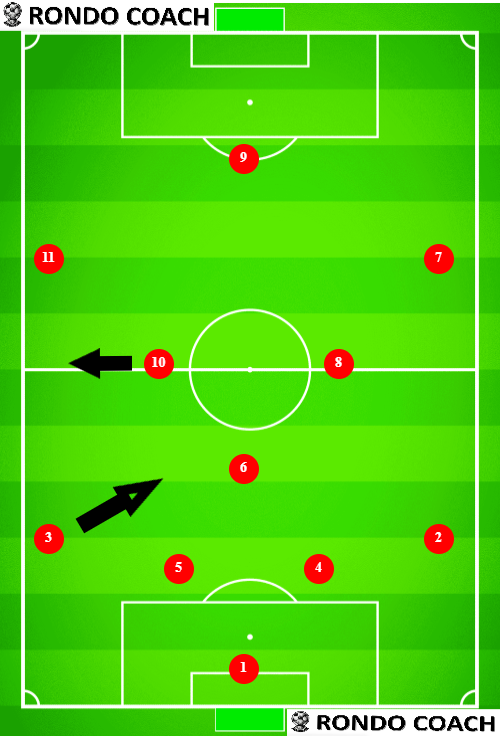What is Carrilero in Soccer? [Complete Tactical Guide]
I often see a midfielder going sideways while everybody is going forward. It is almost as if they are playing their own game. We see that the opponents kind of ignore them and just find them weird. Then all of a sudden, they receive the ball and make a killer assist. When we see a pattern of this repeating in certain teams, we realize that it’s not a random initiative the player takes. It is a tactical pattern instructed by the coach. In order to create chaos in the opposition’s defense and make use of the particular qualities of the players, coaches decide to give special instructions to technically gifted players with great passing range and play them in the carrilero role.
What is the Role of Carrilero in Soccer?
Carrilero is the role of a central midfielder that occupies a wide area of the pitch. The main purpose is to provide support to the wingers without pushing high. Often used in a diamond-shaped midfield, they are the two players on each side of the diamond. They are particularly effective when playing against low-block teams. Carrileros provide a numerical advantage when patiently attacking the flanks. This means that wingers can drop the ball back to them for switching to the other side, but also play one-two passes to them. The players are usually solid technical players with great vision and decision-making abilities.
Formations for a Carrilero
There are lots of different ways to use carrileros. Historically, the role was originally created in the 4-4-2 diamond formation. However, over time coaches looked at smart central midfielders to bring balance to their teams. Any time they saw a hole created by an aggressive fullback or winger, they decided to move a player there. On the other hand, if the midfielder needs to be the aggressive one, then they become mezzalas. This means that often in a 3-5-2 formation, the wide areas are covered by one player, which creates a disadvantage against other teams. Similarly, when using 4-3-3 with an inverted fullback, we have a misbalance in the wide areas. That’s a perfect opportunity for a carrilero to step in.
4-4-2 Diamond

In a classic 4-4-2 diamond formation, the fullbacks act as traditional fullbacks. This means they would often push high, almost wingers when attacking. This would leave a gap on the wide areas between the defenders and the winger area. So, the central midfielder closest to that area would drift to the side to occupy that place. Now, the timing has to be perfect for the player not to block the fullback’s run, but also not too late, so there can be support for it. Lots of communication and smart decision is required for this pattern to give the desired effect.
3-5-2 Formation

The main issue in the 3-5-2 formation is that the players are heavily concentrated in the middle of the pitch. This means that defensively it operates well, but it’s hard to play against similar teams with low blocks. Therefore, while the wingbacks can push all the way to the front of the line or act in a 5 line defense, there will always be a numerical disadvantage against teams that play with both fullbacks and wingers. To fix this we need carrileros. They stay in the heart of the pitch but opportunistically move to the side. They provide support behind the wingback in attack when the wingback pushes forward. Similarly, they play in front of the wingback when we defend with all 5 players. Remember, the wingbacks move vertically, while the carrileros move horizontally.
4-3-3 with an Inverted Fullback

We often create a misbalanced formation when attacking with an inverted fullback. While one of the fullbacks moves as a second pivot, the coach often wants the other side to have the benefit of a fast wingback. Therefore, one side has both a wingback and a winger, while the side that has the inverted fullback has only a wide player – the winger. To provide support, we have the role of a carrilero on that side. This means that at moments we can play in a 4 player central midfield, but other times we can shift one player to the side. On paper that is fine, that is fine to defend. But when the attackers move between these formations, it is going to create opportunities for penetrating runs and passes into space. It is often the carrilero’s job to find these passes.
Attributes of a Carrilero
As it is a very specific role, it is often fluid in the requirements. However, I like to find experienced players to complement the others on the team. First of all, their positioning has to be spot on, otherwise, the team looks chaotic. Secondly, their decision-making has to be right or there is not much point in having them. Finally, their physical attributes are more dependent on agility than pace, as they don’t need to cover lots of ground, but have to win duels.
Attacking traits
The main attacking attributes of a carrilero are technical brilliance, long-range passing, and vision. The technique is developed over time, but it is key for the player to understand how to operate in the middle of the pitch. They usually have the freedom to try uncertain passes to the attackers, but most of the time it is all about ball retention. Having experience playing as a 6 or 8 is important, ideally as a deep-lying playmaker or regista.
Vision means they can see the attacking and defending players. However, that doesn’t mean that they can play all the passes. In fact, good vision without long-range passing ability can lead to switching the ball with shorter passes to the other side. Similarly, long-range passing without vision means that the player might more often find the wingers on the side, even though their poacher keeps making clever runs in front of the goal.
Defending skills
The defensive attributes of carrileros are similar to the ones of box-to-box midfielders or deep-lying playmakers. They need to be able to delay the opponents when playing as a cover for an attacking fullback. They often just need to make sure there is no easy outlet for a counterattack by being good at marking and positioning, rather than recovering the ball. Similarly, we can assume that there are at least 2 or 3 defenders behind them, so speed is not the main consideration here. When playing in front of the fullbacks, presumably in our own half, they need to make sure they drift wide and back to the middle, to create a compact unit with the rest of the team. Positioning is more important than aggressiveness, in this case.
Famous carrileros
There are many players that have played in multiple positions over their career and carrileros were just one of them. Therefore, no soccer player will actually write in their biography that their role was a carrilero. It is more likely that they would play one match there, then the next match maybe as a regista, then box-to-box, and so on.
In more recent history, Jordan Henderson has famously occupied that role in Liverpool. With the wingbacks pushing so high and the wingers often inverting, he brought balance to the squad. Oftentimes, Fabinho in the same system would do the same. That’s a classic example of the 4-3-3 or even 4-4-2 formation with traditional fullbacks needing carrileros.
The most famous carrilero in the 3-5-2 formation is Kante as part of Chelsea FC. Even though he came as a holding mid, he played up in Chelsea to support the wingbacks. Over time the coaches started deploying other players there, such as Kovacic and even Mount, but Kante really excelled in that role.
Finally, I want to give a shoutout to Santi Cazorla in Arsenal. In the early years, he was a winger and sometimes an attacking mid. However, over time his pace and stamina were not up to the standards of the Premier League. So, Wenger started deploying him in the center of the pitch. With his experience, we would often shift to the side as a carrilero, leaving space for the fullbacks and (inverted) wingers to attack. This made the team very unpredictable and difficult to defend against.
Conclusion
There it is – a full guide to carrilero in soccer. We covered what the role is, which formations to use it in, and the characteristics of it. The specificities of the role is so interesting that it cannot be explained in a brief definition, so we decided to get into the details of it. Finally, we gave examples of the players who graced the role at the highest level. They definitely made us think of how to balance our teams to win possession and games.
